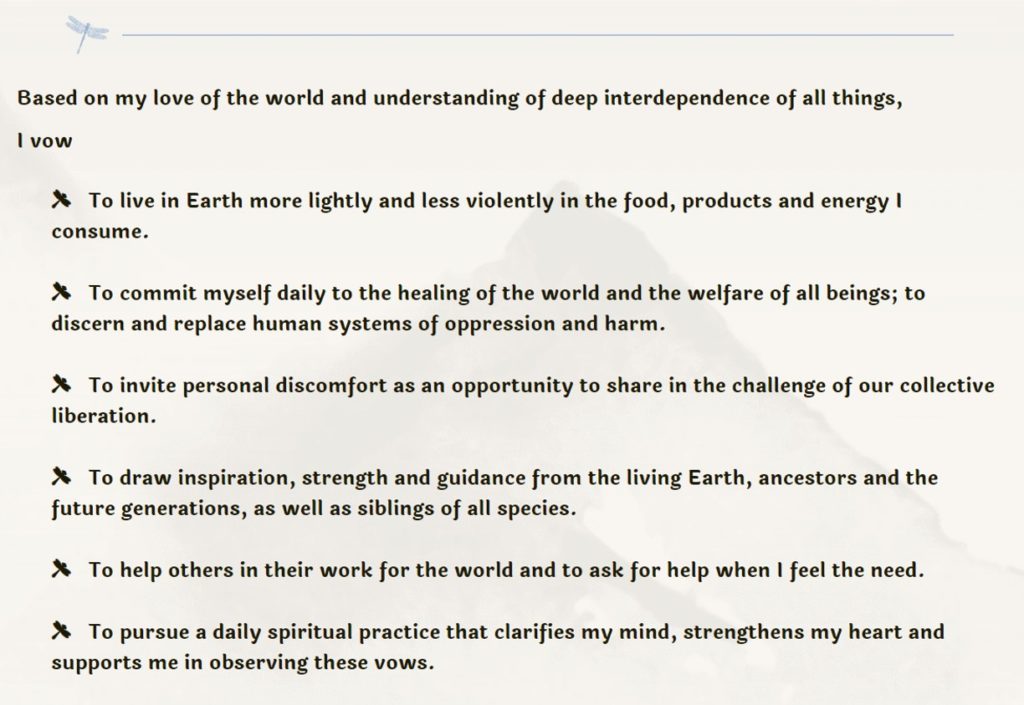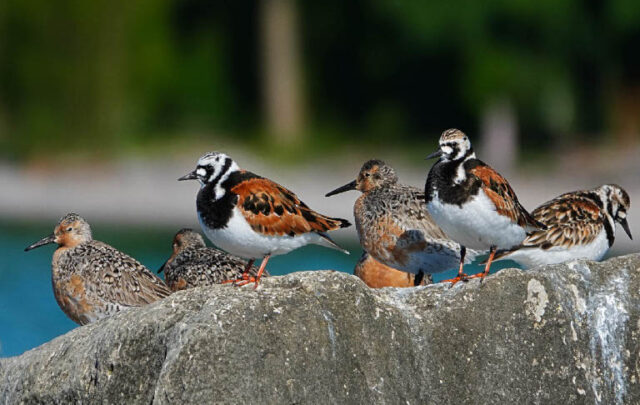I’m excited to share this week’s reflection by Krista Hiser, professor and convener of the Gaian Guild of Hawai’i. This was sparked by a Gaian Conversation about a year ago in which we briefly explored what a green action is vs. what a Gaian action is. Krista, in her reflection, goes far deeper, conveying some differences while also noting that these aren’t necessarily at odds but can work in parallel or support each other. A really important insight! And I’m very grateful to Krista for exploring this topic.
Go with Gaia,
Erik
—
Back in 2019, I had to boycott the campus planning committee for Earth Day. It would have been my 15th consecutive year of Earth Month event planning, and I just couldn’t do it again. First I said, sardonically, “every day is Earth Day!” and then I said, seriously, “we should be mourning, not celebrating. There is nothing to celebrate about the failure of environmentalism.” I proselytized the need to recognize the fear, grief, anger, and shame that college age students report.1
As a faculty member at a public institution of higher learning, academic freedom protects the moral duty I feel to tell students as much of the truth about climate collapse as I can understand, and to use what whatever skills I might have to prepare them for it. We have to talk about this; where better than a college campus?
In my rant to the committee, I vowed that I would attend Earth Day festivities in funereal black. I said I would walk mournfully around the great lawn as clusters of students enjoyed imported fruit smoothies in compostable cups that will never be composted. One colleague agreed with me. She said, “Yes. We should do that for the whole month – Shadow Earth Month!” And thus, our movement of two was born. But 30 days is a lot of black when you live in Hawaiʻi where aloha prints are more the look.

Krista in funereal black in front of a poster of the Sustainable Development Goals in 2019
When people asked us “who died?” we delivered our statement about Shadow Earth Month:
Nobody died, but the Earth is dying. We are wearing black every day in April to raise awareness of environmental grief and climate anxiety. It is a Shadow Earth Month, recognizing the emotions of fear, anger, sadness, and shame. These emotions can be addressed through thoughtful and real conversations about climate change. You are welcome to join us, wear black in April, or just take some time every day to talk to someone about their feelings about climate change.
When 2020 rolled around, of course, we didn’t have the heart for it and then Earth Month moved to Zoom (which, I remind myself frequently, is very far from carbon neutral). Since that month of black I’ve really processed a lot – disappointment and terror, mostly – and learned a lot more about the scope of the predicament (which is the word we use to mean, something that cannot be solved). I have realized that what’s missing from sustainability is simple: spirit.
I went all the way with campus sustainability, and I still appreciate many “green” practices. Sustainability put me on a path toward Gaianism. Gaianism is not a religion, although it fulfills some aspects of a church. Gaianism is an Earth-grounded spiritual philosophy. Gaianism is something you are, and something you do. Gaianism allows the marriage of science and spirituality, something philosophers have discussed for a long time.
In fact, the first transformative environmental book I read was Sex, Ecology, and Spirituality by Ken Wilber, which blew my mind and flipped the switch where first I saw that humans were not “above” nature, but below it and inside it, holonically2 speaking. And in fact, there is no IT!
Wilber’s holons showed me how humans are both included and transcended by nature. Not the other way around. This concept, “include and transcend”, has been a critical scaffold for my thinking about Earth, spirituality, and the state of our world.

We are both included and absolutely transcended by nature. (Image by Mrexentric via Pixabay)
My spiritual path to Gaianism
I was raised by an Atheist and a Baptist who compromised by sleeping in on Sundays, sending me for Saturday night sleepovers and Sunday school with whatever friend would take me. My favorite churches were the Unitarians, who had a zip line, and the Nazarenians, who taught me more geography than I learned at school. I took a Buddhist Philosophy course in college, and have a minor in philosophy. (The only course I ever failed was Kant. I just could not get through Critique of Pure Reason. Maybe this was a good thing.)
Twenty-eight years later, I hosted a cohort of the Ecosattva training from One Earth Sangha. There were ten of us who followed the curriculum, meditated together, and engaged in discussions. Just as the pandemic was starting, we took the Ecosattva Vows.

The Ecosattva Vows. (From Oneearthsangha.org, cited with permission)
These vows are sacred to me as an “everyday bodhisattva.” Ecosattvas are committed to climate action and consideration of the ethics, justice, morality associated with the accelerating and unevenly distributed impacts of climate change. At the same time, in this training we were learning practical climate coping skills like breathing, sitting still, and listening.
That group became the Gaian Guild of Hawaiʻi, and we continue to meet on the first Saturday of every month. In Gaianism, I found the missing aspects of sustainability, and a community of smart and thoughtful people. Last year, in one of the Gaian discussions, I asked the question: “What is Green, and What is Gaian?” and this essay is the result of my pondering that for a year. I invite you now to ponder with me as you do whatever you do (or don’t do) for Earth Month – and you’re invited to Do Nothing for Gaia on May 12, when Gaians celebrate by giving the planet a day off from resource depletion. Yep, just do nothing: read a book, take a walk, sleep. (It’s much more fun than Shadow Earth Day was.)
So, What is Green, and What is Gaian?
Notice that I didn’t say “Green vs. Gaian”. Fundamental to the inquiry is the elimination of binary thinking. It’s not a competition, because Gaianism includes and transcends sustainability. Or as Michael Dowd quite awesomely says in one of his Post Doom presentations, “Includes and Dissolves” it.
Gaianism might involve just a small tweak to something you already do. It’s not that you are “adding a spiritual component”. It’s that you’ve woken up to the awareness of who YOU are, and that you have a direct relationship to Gaia. That “you” are included and dissolved in Gaia.
Here are a few ideas that I came up with, with some input from my Gaian friends. You may find yourself connecting with both columns, or with neither. I invite you participate in this inquiry for yourself, by simply noticing your sustainability or eco-minded actions and decisions this month, and ask yourself, “What is Green, and What is Gaian?”

I take actions from both columns, every day, and like anyone I also lapse into unconsciousness. (How is it possible that I stay inside staring at this screen and forget that a miracle is occurring on the other side of the wall?) I’m so, so far from eco-perfection (we all are) but just being able to meta-cognate this helps me to touch another way of knowing and being. In addition, I am fortunate to live in Hawaii where Aloha ‘Aina (love of the land)3 is practiced sincerely as a worldview and where I have mentors and models to help me observe my mind and behaviors.
Gaianism arrives as a gasp of insight that comes with the rainbow, or the wind. Or the rain. Or an animal or tree being. Who has not experienced this? What we call “nature” is the core reality that is inside us. Michael Dowd refers to nature as G
Holonically, we are inside Earth, which includes and transcends, includes and dissolves. We are part of Gaia, and “going Green”, for me, was the first step to “going Gaian”.
Endnotes
1) See Worry & Hope: What Do College Students Know, Think, Feel and Do about Climate Change.
2) Wikipedia defines a holon as “something that is simultaneously a whole in and of itself, as well as a part of a larger whole.”
3) As Wikipedia defines Aloha ‘Aina: “Its ecological and cultural orientations are founded upon a sense of being connected to all living things. This mutuality between all things exists on many levels: spiritual, social, and the scientific.”





